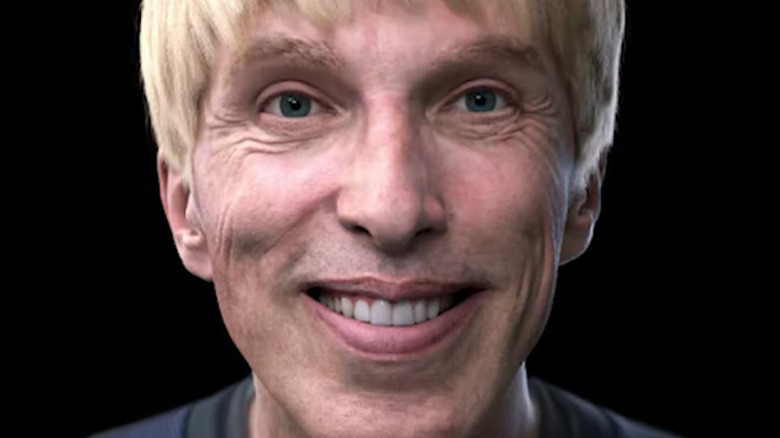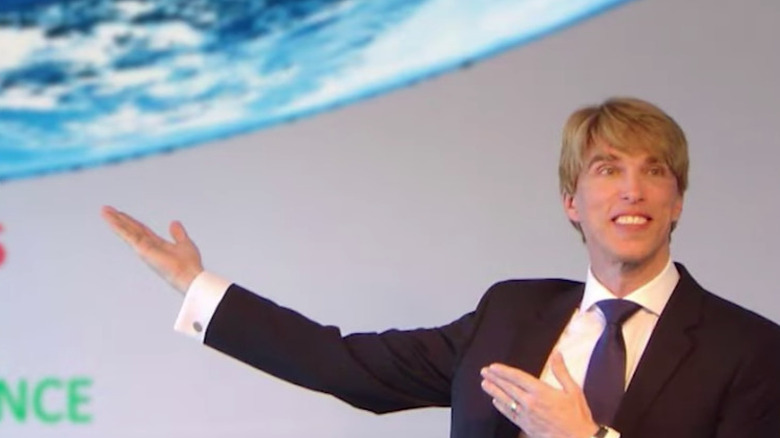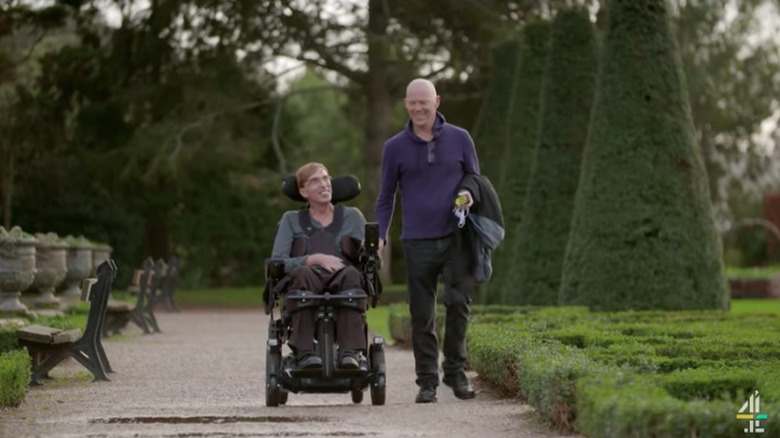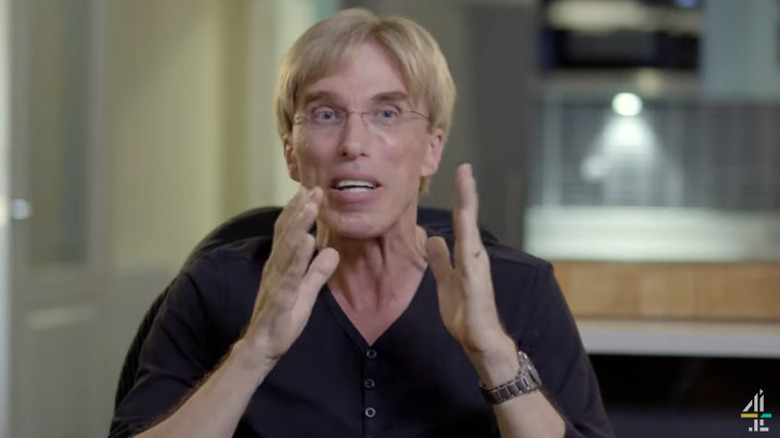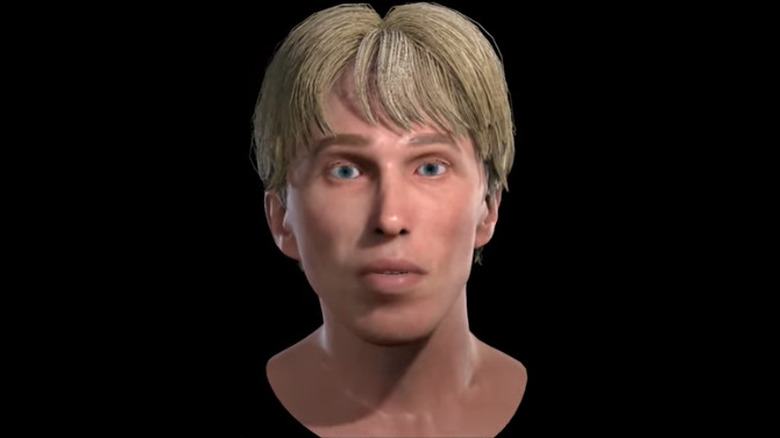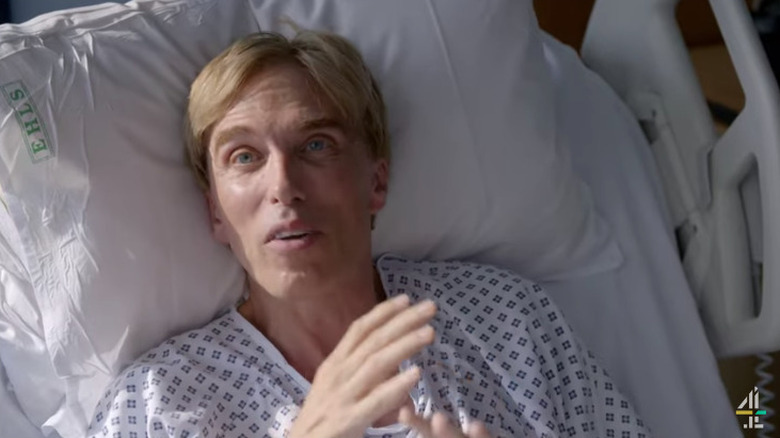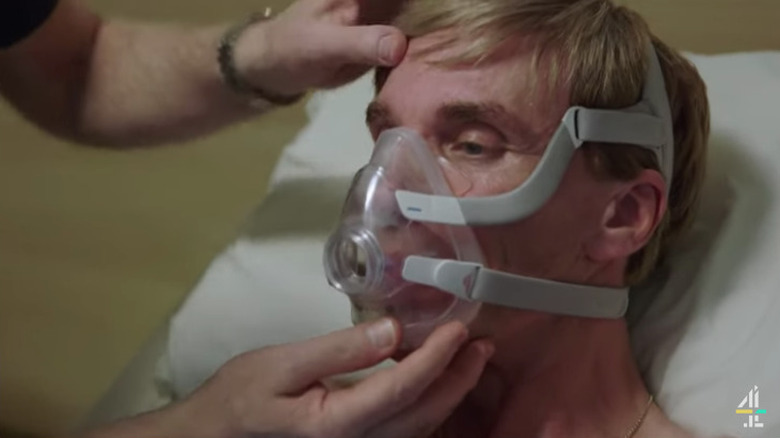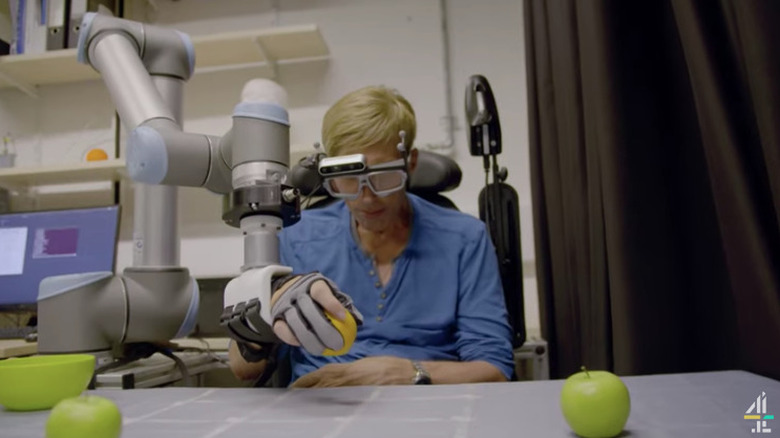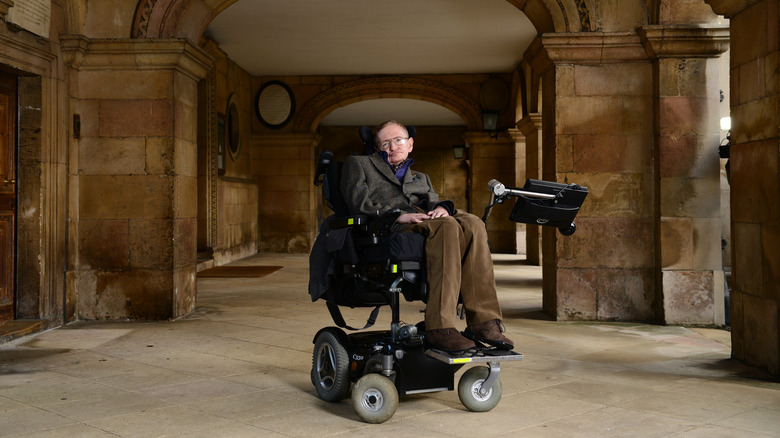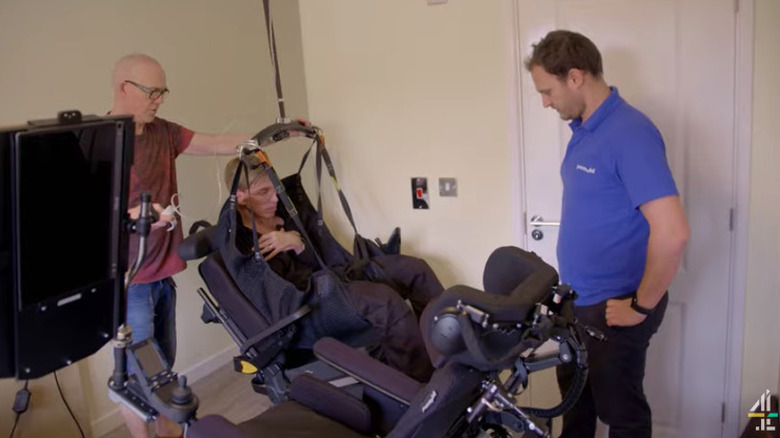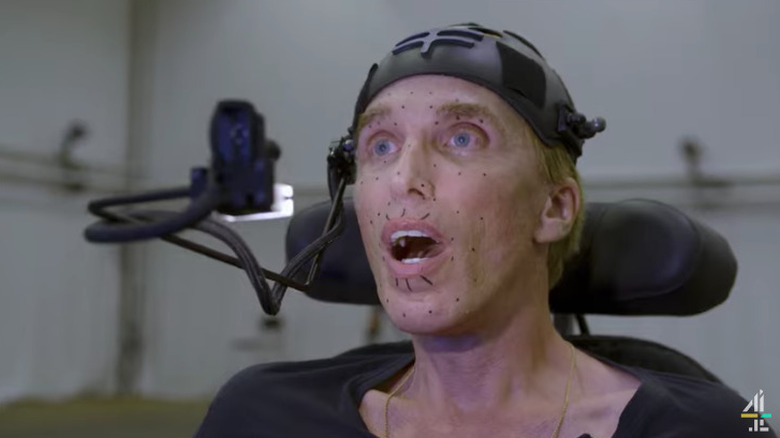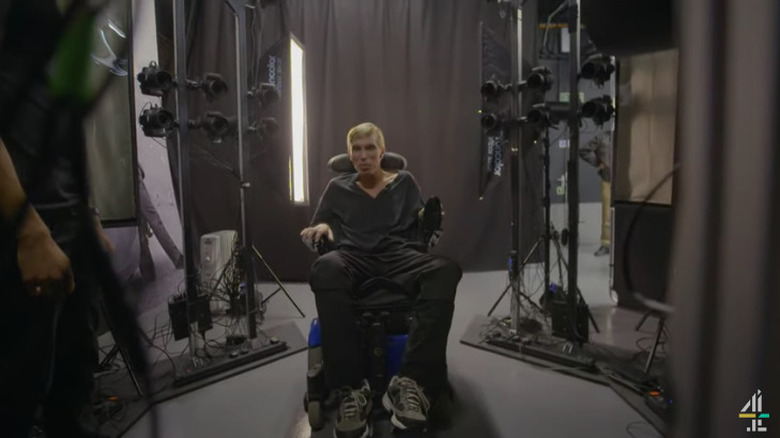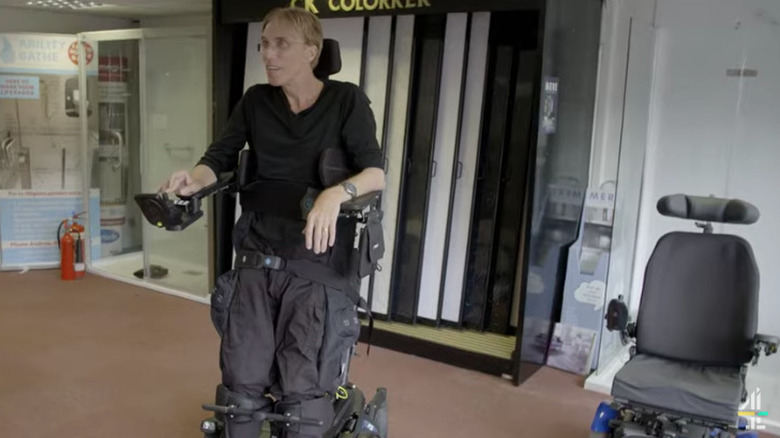The Untold Truth Of The World's First Human Cyborg
Dr. Peter Scott-Morgan, a scientist with a lifelong interest in robotics and artificial intelligence, may have been destined to become the world's first cyborg. Since he was 16 years old, he dreamt up of ways of enhancing human capabilities, and 10 years later, he published a book about the future of robots, "The Robotics Revolution." Scott-Morgan was on his way to achieving his dream. He had numerous surgeries just to optimize a cyborg lifestyle and by 2019, he became what he called Peter 2.0. His face was scanned three-dimensionally in order to create an avatar that would replicate his own facial expressions, and while he wore it on a screen on his chest, he hoped that one day the avatar would be projected onto his face, completely replacing Peter 1.0, per Input Magazine.
But the disease that enabled Scott-Morgan to embark on his cyborg journey was the same disease that ultimately ended his life. In June 2022, he died after a five-year battle with Motor Neurone Disease (MND), per the New York Post. His efforts to become a cyborg in order to survive with a disability leaves behind a monumental legacy in both artificial intelligence research and assistive technology. Read on for a few little-known facts about the world's first human cyborg.
He was the first in Great Britain to receive a PhD in robotics
Peter Scott-Morgan was better-equipped than most people to become a cyborg; he was, after all, the first to receive a doctorate in robotics from a British university. He received it from the Royal Imperial College in London. Then, in 1984, he published "The Robotics Revolution," an authoritative book on robotics, when he was only 26, per Calcalist. With his MND diagnosis in 2017, Scott-Morgan seemed primed for the situation. He immediately began planning how he could transition into part-robot with various surgeries and technological innovations. Despite his circumstances and the bleak prognosis communicated by his doctors, Scott-Morgan was determined to make the most of his situation and use it to embody a lifelong vision, according to Input Magazine.
While announcing the end of "Peter 1.0" on his website, Scott-Morgan said his final procedure would make him not just a cyborg, but "the most advanced human cybernetic organism ever created in 13.8 billion years." He reassured his fans that he wasn't dying but "transforming," via The Herald. Soon, he was able to communicate with others without his voice through eye-tracking technology. Cameras followed his gaze as he visually typed words on a screen, and the results played back in a digitized version of his voice, per The Guardian.
He and his husband were among the first gay couples to marry in England
In 2014, England and Wales formally recognized gay marriages. However, since 2005, gay couples have been allowed to enter civil unions. Although activists consider the 2014 law to be the official achievement in marriage equality, it was the 2005 law that finally allowed gay couples the same rights and privileges as heterosexual couples, per Reuters. And it was then that Peter and Francis Scott-Morgan wedded after a 27-year relationship. They were among the first gay couples in Great Britain to marry, and their wedding had the Mayor of Torbay, England. in attendance. Peter and Francis had already hyphenated their last names 15 years prior. Their union was a historical event, and Peter told the BBC News that only a decade before he and Francis met, British law would have allowed them to be imprisoned.
The couple met in 1979 at a gay hotel, where Francis was the clerk. They lived together in London while Peter earned his doctorate, and moved to the United States where he found a job. The adversity they faced as a gay couple provided them with the inspiration and strength for Peter's cyborg transformation. In an interview with The Guardian, Francis compared society's pessimism toward gay couples to doctors' somber expectations toward Peter's life expectancy: if the couple could carve out a living as a gay couple in a hostile environment, they could also adapt to Peter's cyborg transition.
He was given two years to live
It was in November 2017 that Peter Scott-Morgan received the diagnosis that would change the few remaining years of his life: he had Amyotrophic Lateral Sclerosis (ALS), or as it is known in the UK, Motor Neurone Disease (MND). It's a degenerative disease that inflicts the motor neurons in the brain and spinal cord, causing them to lose control of muscle movement, per Input Magazine. It results in paralysis throughout the body, and one-third of victims die within a year. One-half of victims die within the second year, according to The Guardian. Although the brain itself is spared, death is usually caused by respiratory failure.
Scott-Morgan's first symptoms occurred when he emerged from a bath while on a trip to the Arctic Circle. He realized he couldn't shake the water from his feet. A few years after his diagnosis, Scott-Morgan depended on a group of caregivers to help him get ready in the morning. His routine, which began at seven in the morning, involved physiotherapy and cleaning and maintenance of his cyborg tech, including a screen he used to communicate that was attached to his chest, per The Guardian.
He had already been interested in extending his life with AI
Peter Scott-Morgan's MND diagnosis would be enough to emotionally break any normal person, but he was anything but. While still in consultation with the doctor breaking the news, and just as he pondered how to inform his husband, Scott-Morgan was already planning his future. A roboticist and AI-enthusiast, Scott-Morgan was more prepared than most people to adapt to this new normal. In his 1984 book "The Robotics Revolution," Scott-Morgan argued that as artificial intelligence evolved, humans could begin replacing their anatomical parts with what he called "permanent mechanisms." As The Guardian explained, he called this idealized specimen an "enhanced human."
Scott-Morgan also credited "Star Trek" and "Doctor Who," whose science-fiction elements inspired him to believe he could accomplish anything with the right technology (via This Morning). He called the TV shows his earliest source in science education. Additionally, when he was only 16, he fantasized and wrote essays about adjoining his human brain with a robotic one in order to enhance his intelligence, per Input Magazine.
The key to his survival was to re-engineer his lungs
Peter Scott-Morgan realized that in order to optimize his chances for survival, he needed to do something about his lungs. MND itself isn't fatal, but it prevents the muscles in the lungs from working, which results in most MND deaths. But Peter merely saw it as an engineering problem. In an interview with This Morning, Francis Scott-Morgan explained, with Peter in attendance, that Peter's surgical operations prevented his lungs from failing. As a result, the surgeries should've given Peter a normal life expectancy.
That wasn't the only pioneering and risky surgery Scott-Morgan received. He also restructured his stomach in a procedure that required special permits from British health authorities. Scott-Morgan called the three surgeries a "triple-ostomy;" one tube was inserted to transfer food to his stomach, and two tubes were inserted to drain out feces and urine. If successful, the tubing would allow Scott-Morgan to discharge his waste without help from caregivers and allow him to absorb more nutrients. Essentially, the surgeries allowed him to stay ahead of his disease. Doctors were hesitant to perform the procedure on otherwise healthy organs, and Scott-Morgan ended up firing his first doctor in order to move forward. Its success led the surgery to being selected as the 2019 Oxford Medical Case Report, according to Input Magazine.
His operation included a removal of his voice box
Peter Scott-Morgan's last operation before his complete cyborg transformation was a laryngectomy — a removal of his voice-box. The procedure prevented a potential flooding of his lungs with saliva. It marked the end of "Peter 1.0," according to Scott-Morgan. He was in intensive care for 24 days and now depended on a ventilator to help him breathe. Ironically, the laryngectomy occurred in the same month doctors told him he was projected to die, and he believed the procedure would afford him more decades to live, per The Herald.
But Scott-Morgan didn't want to lose his voice completely. Before losing the ability to speak, Scott-Morgan visited a Scottish sound laboratory to record his voice and preserve its various intonations and inflections. They were then synthesized into a digital voice he could use once he was a cyborg, per Calcalist. It was important for Scott-Morgan that he retained the character and humanity of his original voice in order to convey emotion, as reported by the New York Post. His digital voice was even programmed to sing "Pure Imagination," even though the original Peter 1.0 couldn't sing. Hearing the song made him and his family emotional, as it presented the limitless opportunities that the technology could bring — including a future in which he could speak various languages (via The Guardian).
He considered himself to be a human guinea pig
With the new technology he used to pioneer a revolutionary way of living and being human, Peter Scott-Morgan knew he was a human guinea pig. The surgeries he received to essentially re-plumb his stomach needed special permission from UK health authorities, per Calcalist. Not just that — he struggled to find doctors who were willing to perform them. But because he refused to succumb to MND, he was willing to offer up his own body to science. It wasn't just a matter of survival, either. As a true scientist, he was interested in knowing how far technology could go to bring science fiction into reality, according to his interview with Input Magazine.
But his body had its limits and ultimately couldn't keep up with his lifelong vision. A self-driving wheelchair that would've given him better mobility than anything currently on the market never came to fruition because his health began to fail (via Calcalist). On Twitter, Scott-Morgan informed his followers in April that he had gone silent on the social media site for two months due to the limited muscle movement he had to close his eyes. His eyes become very dry, disrupting his eye-tracking technology. However, it seemed that technology would continue to keep up. In May — only a month before his death — Scott-Morgan informed his followers that his team was now helping him communicate by only thinking, which illustrates how far Scott-Morgan could have gone with new cyborg technology.
His team worked with Stephen Hawking
Stephen Hawking was a natural source of inspiration for Peter Scott-Morgan: both devoted their lives to science and both were inflicted with the same disease. It helps that Hawking survived MND by 50 years, a longevity Scott-Morgan strove for. Scott-Morgan was able to meet Hawking in 2018 before the latter passed away and received a pearl of wisdom that helped Scott-Morgan through adversity: "Focus on what you can do, not on what you can't" (via the New York Post).
Luckily for Scott-Morgan, he was able to work with the same engineers who helped Hawking. He worked with Thorsten Stremlau at Lenovo to build his eye-tracking technology, smart cameras, and all the other intelligence hardware needed to bring his cyborg vision to life. Stremlau and Lenovo previously worked with Hawking to build his wheelchair-and-laptop communication system. He also worked with the director of the Human & AI Systems Research Lab at Intel, Lama Nachman, who developed Intel's Assistive Context-Aware Toolkit. This system helped Hawking when he lost control of his hands and could only communicate by way of a cheek muscle, using a simulated keyboard and word prediction, per Input Magazine.
He embraced sedentary life
The "locked-in" reality of MND might have been one of the hardest aspects of the disease for someone as lively and energetic as Peter Scott-Morgan. Scott-Morgan called the possibility of being in pain without the ability to ask for help a "waking nightmare of being locked-in, trapped in impotent silence within the straightjacket [sic] of your own living corpse" (via Input Magazine). Even without physical pain, the paralysis itself without the ability to communicate is nightmarish enough. When it came to his synthesized voice, it was important for Scott-Morgan to personalize it or he else would have felt "isolated," according to the New York Post.
But Scott-Morgan had confidence in his cyborg technology, which included cameras and other hardware that detected discomfort and alerted his caregivers. He also made peace with his sedentary life, comparing the experience to a luxury spa hotel in which the maître d insists that he put feet up and not move at all. In an interview with Stephen Fry, Scott-Morgan's AI interface compared himself to a pharaoh and said he discovered his inner couch potato. He added that joy was less a result of one's environment but an act of will (per Literary Hub).
He hoped to help others with disabilities
Peter Scott-Morgan knew he was pioneering a new way to be human, so it was obvious his methods could help others with MND and similar disabilities. He and his husband, Francis, set up a charitable research organization called the Scott-Morgan Foundation. The Foundation has worked with designers, engineers, and doctors at companies like Intel, CereProc, DXC, and Lenovo to design his personal cyborg tech and other cutting-edge technology that could help people with disabilities. DXC worked with the Foundation to improve the life-like communication timing of Peter's second-generation avatar, Peter 2.0. The Foundation's design and innovation director, Esther Duran, worked with Intel to also improve Peter's AI communication system, which includes a keyboard simulation and speech synthesis. Prior to Scott-Morgan's death, the Foundation was on the verge of transforming his house into a smart home, replete with smart light bulbs and thermostats, according to Input Magazine.
Peter called his team at the Foundation, and all those who pitched in, rebels. Calling his tech movement a "rebellion" was fitting since he sought to rewrite the rules on how disabled people can survive, per This Morning. On its website, the organization offers disability victims a chance to clone their voices, just as Peter had done, through CereProc technology (via Scott-Morgan Foundation). In 2021, the Foundation also collaborated with Lenovo on its Kind Cities Campaign, which advocated the need for kindness between various communities.
Morgan-Scott extended his life by nearly three years
When Peter Scott-Morgan died in June 2022, he outlived his projected life expectancy by nearly three years, and it had been nearly five years since he was diagnosed with the disease MND. In November 2017, his doctors told him he would live for only two more years, but he surpassed those expectations. His post-diagnosis lifespan is nothing to sneeze at; MND mortality rates double every subsequent year after its inception, per The Guardian. What's more, Scott-Morgan said his quality of life was "exceptional" in an April 2021 interview with This Morning. He said that despite his condition, he still had fun and mostly importantly, he was still alive.
On June 15, his Twitter account alerted his followers to his death. The post said he died peacefully while surrounded by family and friends. It didn't specify as to what specifically caused his death, but the assumption is that it was due to his MND affliction. Previous updates hinted at his worsening health condition, including a post on April 8 that said he had trouble blinking, which then interfered with his communication technology (via Twitter).
He had dreams of further transformation when he died
Peter Scott-Morgan's death in June 2022 tragically cut short a few lofty goals he set to solidify himself as the world's first cyborg. Those goals would've involved pioneering forms of technology that would convince the average person that he was no ordinary human. One plan involved projecting an avatar onto his face in order to simulate muscle movement and emotions, per The Guardian. This new avatar was being developed by Pinewood Studios — the same company that digitally replicated Carrie Fisher's younger face for "The Rise of Skywalker" — and it would have expressed all of the complex emotions that his first avatar couldn't. The engineering team's hardest challenge was to synchronize all of the movements across the avatar's face for a single emotion, i.e., an eyebrow would lift along with a lip parting to convey surprise. Ideally, the avatar would have been indistinguishable from a real person, according to Input Magazine.
Scott-Morgan also had plans for a next-generation self-driving wheelchair. It would have been able to hold his body upright, lay flat, and accelerate quickly. He called it Charlie, which stood for "Cyborg Harness and Robotic Locked-In Exoskeleton." It would've been so much more advanced than existing automotive wheelchairs that Scott-Morgan imagined himself maneuvering around a showroom of porcelain vases. Additionally, as reported by Input Magazine, his home was being redesigned to accommodate him with smart technology. Biosensors reading his body temperature would have adjusted the temperature of his room accordingly.
